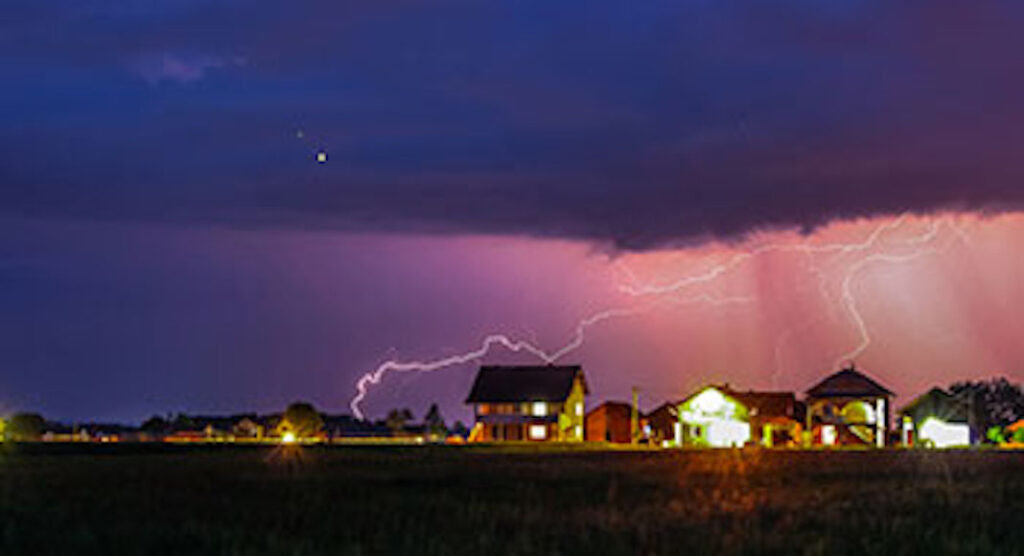
Texas Border Business
The weather forecast calls for a slight chance of thunderstorms, but you can only see a few fluffy white clouds overhead. So you and your tennis partner grab your racquets and balls and head for the tennis court. You spend a few minutes warming up and then—wait! Is that thunder you hear? Was that a lightning flash?
What do you do? Keep playing until the thunder and lightning get closer? Go sit on the metal bench under the trees to see what happens? Or get in your car and drive home?
Correct answer: If no substantial, non-concrete shelter is nearby, get in your car and wait out the storm.
Why? Because being outside when lightning is present is not something to take lightly—ever.
Risks of Lightning Strikes
Although the odds of being struck by lightning in a given year are less than 1 in a million, some factors can put you at greater risk. Lightning most often strikes people who work outside or engage in outdoor recreational activities. Regional and seasonal differences can also affect your risk of being injured by lightning.
In 2020, Florida and Texas had the most lightning deaths. Florida is considered the “lightning capital” of the country, with more than 2,000 lightning injuries over the past 50 years.
The consequences of lightning strikes are serious. Lightning is one of the leading causes of weather-related fatalities. From 2009–2018, lightning caused an average of 27 deaths per year in the United States.

Protect Yourself from Lightning Strikes
When you see lightning, take safety precautions.
Safety precautions outdoors
You can protect yourself from risk even if you are caught outdoors when lightning is close by.
- If the weather forecast calls for thunderstorms, postpone your trip or activity.
- Remember: When thunder roars, go indoors. Find a safe, enclosed shelter. Safe shelters include homes, offices, shopping centers, and hard-top vehicles with the windows rolled up.
- Don’t forget the 30-30 rule. After you see lightning, start counting to 30. If you hear thunder before you reach 30, go indoors. Suspend activities for at least 30 minutes after the last clap of thunder.
- If you are caught in an open area, act quickly to find adequate shelter. The most important action is to remove yourself from danger. Crouching or getting low to the ground can reduce your chances of being struck but does not remove you from danger. If you are caught outside with no safe shelter nearby, the following actions may reduce your risk:
- Immediately get off elevated areas such as hills, mountain ridges, or peaks.
- Never lie flat on the ground. Crouch down in a ball-like position with your head tucked and hands over your ears so that you are down low with minimal contact with the ground.
- Never shelter under an isolated tree.
- Never use a cliff or rocky overhang for shelter.
- Immediately get out of and away from ponds, lakes, and other bodies of water.
- Stay away from objects that conduct electricity (such as barbed wire fences, power lines, or windmills).
- Stay away from concrete floors or walls. Lightning can travel through any metal wires or bars in concrete walls or flooring.
Safety precautions indoors
Being indoors does not automatically protect you from lightning. In fact, about one-third of lightning-strike injuries occur indoors. Here are some tips to keep safe and reduce your risk of being struck by lightning while indoors.
- Avoid contact with water during a thunderstorm. Do NOT bathe, shower, wash dishes, or have any other contact with water during a thunderstorm. Lightning can travel through plumbing.
- Avoid using electronic equipment of all types. Lightning can travel through electrical systems and radio and television reception systems.
- Avoid using corded phones. Corded phones are NOT safe to use during a thunderstorm. However, cordless or cellular phones are safe to use during a storm.
- Avoid concrete floors and walls. Do NOT lie on concrete floors during a thunderstorm. Also, avoid leaning on concrete walls. Lightning can travel through any metal wires or bars in concrete walls or flooring.
Lightning strikes may be rare, but they still happen and the risk of serious injury or death is severe. Take thunderstorms seriously
Learn and follow these safety rules to keep yourself safe from lightning.













